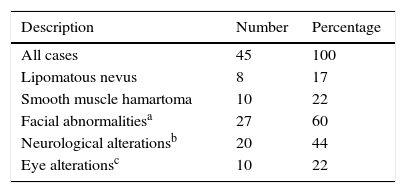The term Michelin tire baby (MTB) was first used in 1969 by Ross1 to refer to the case of a baby with multiple, widespread skin folds associated with hemihypertrophy and a broad bridge of the nose. We report the case of a girl with MTB and mild associated dysmorphic alterations.
A 3-month-old girl of Romanian origin, born at 34 weeks, with no history of consanguinity, was seen for excessive skin folds. She had no personal or family history of interest. Physical examination revealed abundant circumferential folds of skin of soft but solid consistency around the limbs and neck (Fig. 1). In addition, we observed microcephaly with frontotemporal flattening and hypotelorism, small, low-set ears, and teletelia. Skin biopsy showed an excessive accumulation of adipose tissue in the superficial dermis (Fig. 2). Cardiology study and transfontanellar ultrasound were normal. Ophthalmologic examination revealed convergent strabismus, microphthalmos, and blepharophimosis. The karyotype was normal, 46 XX.
A proposal has been made to replace the original term Michelin tire baby by the term circumferential skin folds syndrome or phenotype when the condition is associated with extracutaneous alterations.2 These associated manifestations, detected in up to 74% of MTB patients, include facial abnormalities, neurologic disturbances (mental retardation, delayed psychomotor development, hypotonia, convulsions), ocular and cardiac alterations, genital hypoplasia or malformation, scoliosis, and pectus excavatum (Table 1).2–5 Our patient presented teletelia, not previously reported in association with MTB. To date, no consistent pattern of inheritance has been identified.6
Summary of the Number and Percentage of Cases of Circumferential Skin Folds Syndrome Reported in the Literature up to the Time of Writing This Review Article, Including Our Case.
| Description | Number | Percentage |
|---|---|---|
| All cases | 45 | 100 |
| Lipomatous nevus | 8 | 17 |
| Smooth muscle hamartoma | 10 | 22 |
| Facial abnormalitiesa | 27 | 60 |
| Neurological alterationsb | 20 | 44 |
| Eye alterationsc | 10 | 22 |
Most frequent facial abnormalities, reported in 3 or more patients: malformations of the auricles of the ear, broad or sunken bridge of the nose, epicanthic folds, hypertelorism, cleft palate, microphthalmos, micrognathia, and central facial flattening.
Most frequent neurologic abnormalities, reported in 3 or more patients: delayed psychomotor development, mental retardation, dilatation of the ventricles, hypotonia, convulsions, and microcephaly.
Most frequent eye abnormalities, reported in 3 or more patients: blepharophimosis and strabismus or esotropia.
Source: Adapted and updated from Rothman2 2014.
Histology in MTB can reveal signs of smooth muscle hamartoma, lipomatous nevus, degenerated collagen, scarring, or even normal skin, although biopsy was not performed in 59% of reported cases.1,3
This new case of MTB with lipomatous nevus associated with facial dysmorphism, ocular alterations, and teletelia, highlights the need to perform complete clinical evaluation in these children, including neurologic and ophthalmologic examination. When associated malformations are present, the term circumferential skin folds syndrome should be used.
Conflicts of InterestThe authors declare that they have no conflicts of interest.
Please cite this article as: Noguera-Morel L, Andrés-Ramos I, Hernández-Martín A, Torrelo A. Bebé Michelin asociado a anomalías faciales. Actas Dermosifiliogr. 2016;107:530–531.









